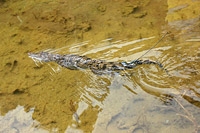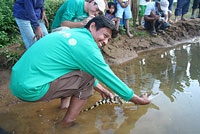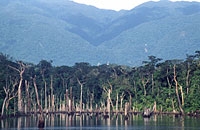
New chance for the Philippine crocodile
On Friday 13 July, fifty Philippine crocodiles (Crocodylus mindorensis) bred in captivity were released into a lake in the Northern Sierra Madre Natural Park on the northern Philippine island of Luzon. Researchers at Leiden University are hoping this will help speed up the recovery of the crocodile population. The Philippine crocodile is one of the world's most endangered animal species. According to estimates, there are less than a hundred adult members of the species left in the wild.
Effective measures

Since 1999 researchers Merlijn van Weerd and Jan van der Ploeg from the Institute of Environmental Sciences (CML) have been working on research into and the protection of the Philippine crocodile. In collaboration with the Ministry for the Environment, local authorities and village communities, they have tried to find solutions for preserving this species in the wild. And their efforts are bearing fruit: the main threats - hunters, the use of destructive fishing methods, and the loss of their natural habitat - have been addressed effectively. The Philippine crocodile population is now recovering, albeit slowly.

Dicatian Lake
The idea is that releasing crocodiles bred in captivity should speed up the recovery rate. In the past year, there have been intensive discussions with fishermen, land owners, surrounding village communities and the local council about the reintroduction of crocodiles into the lake. There is broad social support for the release of these fifty young crocodiles in the Dicatia Lake in the province of Divilacan.
Endemic species

The Philippines is a priority area for international nature preservation. Hardly anywhere else in the world are there so many endemic species (species with a limited area of habitation) so strongly endangered as in the Philippines; these species include the Philippine crocodile and the Philippine Eagle. The Northern Sierra Madre Natural Park was established, partly with development assistance from the Netherlands. It is the largest and one of the most important protected areas in the Philippines. Since 1989, researchers and students from Leiden University have been conducting research on this unique natural habitat. In the coming months Dutch and Philippine students will be tracking the crocodiles they have released, with the help of radio transmitters.
A long journey
The crocodiles were put into crates on Tuesday 28 July. The following day they were flown from Palawan to Manilla, and from there they travelled by car to Isabela. On Thursday they were loaded ito a helicopter for the journey to the Northern Sierra Madre Natural Park. On Friday, at the end of a long journey, the researchers released their young charges into the lake.
(28 July 2009 - adapted on 11 August)
